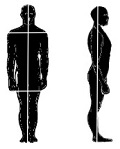
Bad workmen have always blamed their
tools. It's still happening, only this time it's the desk, the chair and
the mouse - or if you work outside, the seat, the steering wheel, the floggle-toggle, the broom
or the shovel - that get the blame.
Of all the health assessments we conduct
in the workplace, this one appears to be most pressing. This is because
close to 50% of people regularly experience musculo-skeletal pain.
Ask any group of people to rate the current condition of their
musculo-skeletal system and 50% will give themselves 5/10 or less.
Most don't complain, they think a certain amount of joint and muscle
pain is normal. They blame their age, their occupation or the sport they
played when they were young, they put up with it.
Their physician is clueless about diagnosing causation. They don't know
where to look. This being the case they don't know what to prescribe to
treat the problem.
One thing is clear, back (and most other joint and muscle pain) is not
caused by a lack of rubbing, crunching, heating, vibrating, strapping,
doping or surgery. The most common prescription is a pill to mask the
pain. The problem gets worse.
Those that make a serious complaint become
part of a very expensive therapeutic merry-go-round; which means
a lot of money is spent but not much progress is made toward making
people stronger and more flexible, restoring
poor function to good, getting their skeletons back into better
alignment, and relieving the principal symptom - pain!
The Ten Point Musculo-skeletal Risk assessment profile
provides individuals and organisations with an audit of current and
future risk - plus the tools they need to get themselves back into
alignment. The tools are called strength and flexibility exercises. You
have to do them to yourself; no-one can do them for you.
We normally conduct the assessment as
part of the Musculo-skeletal Health Seminar.
TEN POINT MUSCULO-SKELETAL RISK ASSESSMENT
Give yourself a score out of ten,
appropriate for your performance on each of the ten questions below.
A good score is a high score. A poor score is a low score.
If you don't think it is safe for you to do any of these
tests don't do them. If it hurts, stop doing the test immediately. These
tests are safe and easy to complete for people in good musculo-skeletal
health.
Items in red - squats, situps
and pressups are the Fit-for-Work tests.
|
1. |
Current musculo-skeletal condition
How would you rate the current
condition of your musculo-skeletal system? |
|
|
|
|
|
Poor |
|
|
|
|
|
|
|
Good |
|
Ex |
|
|
|
|
|
0 |
1 |
2 |
3 |
4 |
5 |
6 |
7 |
8 |
9 |
10 |
|
|
|
|
|
|
|
|
|
|
2. |
Body composition
How
close are you to your ideal weight? Estimated kilograms
over your ideal weight or percent
body fat.
|
Weight
|
 |
|
|
 |
|
|
Obese |
|
|
|
|
|
|
|
|
|
Slim |
|
|
|
|
Kg |
>35 |
<35 |
<30 |
<25 |
<20 |
<15 |
<10 |
<6 |
<4 |
<2 |
|
|
|
|
%BF/M |
>40 |
<40 |
<40 |
<35 |
<30 |
<27 |
<23 |
<20 |
<18 |
<15 |
|
|
|
|
%BF/F |
>50 |
50 |
45 |
40 |
38 |
36 |
34 |
32 |
30 |
28 |
|
|
|
|
|
0 |
2 |
3 |
4 |
5 |
6 |
7 |
8 |
9 |
10 |
|
|
|
|
|
|
|
|
|
|
3. |
Abdominal strength
- feet held
How many situps can you do until exhaustion with your feet
held. Lie down on
your back with feet flat, knees bent at 90 degrees, arms
crossed and fingers holding your shoulders. Sit up so
your elbows tough your knees. Don’t count those situps where
your elbows don't touch your knees.
|
Number until exhaustion. |
 |
|
|
 |
|
|
Poor |
|
|
|
|
|
|
|
|
|
Good |
|
|
|
|
|
<5 |
5 |
7 |
9 |
11 |
14 |
17 |
20 |
23 |
25 |
30 |
|
|
|
|
|
0 |
1 |
2 |
3 |
4 |
5 |
6 |
7 |
8 |
9 |
10 |
|
|
|
|
|
|
|
|
|
|
|
|
|
|
|
|
|
|
|
|
4. |
Upper body strength
How many pressups can you do until exhaustion; women on the knees
and men on the toes. For women make sure your knees, bottom and
shoulders are in a straight line; ie your backside shouldn’t be
sticking up in the air. Don’t count those pressups where the
body flops onto the floor.
|
Number until exhaustion. |
 |
|
|

 |
|
|
Poor |
|
|
|
|
|
|
|
|
|
Good |
|
|
|
|
|
<5 |
5 |
7 |
9 |
11 |
14 |
17 |
20 |
23 |
25 |
30 |
x |
x |
|
|
|
0 |
1 |
2 |
3 |
4 |
5 |
6 |
7 |
8 |
9 |
10 |
|
|
|
|
|
|
|
|
|
|
|
|
|
|
|
|
|
|
|
|
5. |
Squat
From a standing position, how many times
can you squat down, with backside at least half way
between your knees and the floor
as they will go, and stand up straight,
until exhaustion. You may use a heel raise (as illustrated
if you need to.)
|
Number until exhaustion. |
 |
|
|
|
|
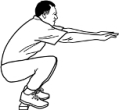 |
|
|
Poor |
|
|
|
|
|
|
|
|
|
Good |
|
|
|
|
|
<5 |
5 |
7 |
9 |
11 |
14 |
17 |
20 |
23 |
25 |
30 |
|
|
|
|
|
0 |
1 |
2 |
3 |
4 |
5 |
6 |
7 |
8 |
9 |
10 |
|
|
|
|
|
|
|
|
|
|
|
|
|
|
6. |
Sit
and reach -
hamstring flexibility
In a sitting position, with legs outstretched in front of you,
see how far down past your toes you can reach with your fingers.
Keep legs straight and backs of knees on the floor. Score 4 if you can get your fingers to
your toes (T), 5 for the first knuckle, 6 for the second and 7
if you can get to the palms (P). Score 10 if you can get your
wrists past your toes (W).
|
 |
|
|
Poor |
|
|
|
|
|
|
Good |
|
|
|
|
|
Can't touch toes |
F |
|
|
P |
|
|
W |
|
x |
|
|
|
0 |
4 |
5 |
6 |
7 |
8 |
9 |
10 |
|
|
|
|
|
|
|
|
|
|
|
|
|
|
|
|
|
|
|
|
7. |
Ability to sit up straight - buttock
flexibility
With legs crossed and hands clasped behind the back, see if
you can sit up straight without falling over.
Your score is based on the worst of the scores for each side.
Falling over backwards on
either side scores 0.
|
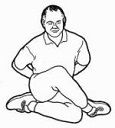
|
|
|
Fall over when hands clasped behind back |
Just |
|
|
Good |
|
|
|
|
|
0 |
7 |
8 |
9 |
10+ |
|
|
|
|
|
|
|
|
|
|
|
|
|
|
|
|
|
|
|
|
8. |
Shoulder function - wall test
Stand with your back to the wall. Place your hands in the surrender position
with elbows, forearms, wrists and fingers flat back on the wall. Score 10 if
you can do this with ease. Score low if you have difficulty getting into
this position or lower still if your elbows and wrists are a long way from
the wall. |
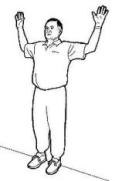 |
|
|
Forearm, wrists and fingers
not flat against wall |
Just |
|
Easy |
|
|
|
|
|
0 |
4 |
5 |
6 |
7 |
8 |
9 |
10 |
|
|
|
|
|
|
|
|
|
|
|
|
|
|
|
|
|
|
|
|
9. |
Strength training behaviour
Do you have a regular and systematic strength
training program? No. of sessions per week |
|
|
|
|
|
0 |
|
|
1 |
|
|
2 |
|
|
|
3 |
|
|
|
|
|
0 |
1 |
2 |
3 |
4 |
5 |
6 |
7 |
8 |
9 |
10 |
|
|
|
|
|
|
|
|
|
|
|
|
|
|
|
|
|
|
|
|
10. |
Flexibility training behaviour
Do you have a regular and systematic flexibility
training program? No. of sessions per week |
|
|
|
|
|
0 |
|
|
1 |
|
|
2 |
|
|
|
3 |
|
|
|
|
|
0 |
1 |
2 |
3 |
4 |
5 |
6 |
7 |
8 |
9 |
10 |
|
|
|
|
|
|
|
|
|
|
|
|
|
|
|
|
|
|
|
|
|
|
|
|
|
|
|
|
|
|
Total |
|
|
|
YOUR RISK OF
MUSCULO-SKELETAL FUNCTION IS
ASSESSED AS: -
●
Very low if you scored over 80
●
Low if you scored over 70
●
Medium if you scored between 50 and 70
●
High if you scored less than 50
If you scored less than 50
we suggest you attend the Global Back Care Clinic - or a yoga, tai chi, Pontius Pilates, Body
Balance, Pump or Complete Workout program three times a week. Do that and
you'll get your musculo-skeletal system back into very good shape in a few
months. You'll feel the difference after a couple of weeks.
SAMPLE RESULTS
 The evidence -
Amalgamated Musculo-skeletal Health Risk report spreadsheet
The evidence -
Amalgamated Musculo-skeletal Health Risk report spreadsheet
 The evidence -
'Oodnawoopwoop Council' Musculo-skeletal Health Risk report
spreadsheet
The evidence -
'Oodnawoopwoop Council' Musculo-skeletal Health Risk report
spreadsheet
 The evidence -
'Oodnawoopwoop Council' joint condition spreadsheet
The evidence -
'Oodnawoopwoop Council' joint condition spreadsheet
WORKPLACE ACCIDENT INSURANCE BLUEPRINT
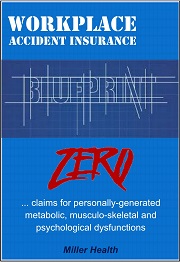
Click here to download a copy of the Workplace Accident
Insurance Blue Print - a must read for Workplace Health and
Safety managers.
Miller Health
7 Salvado Place, Stirling (Canberra)
ACT 2611 Australia
(02) 6288 7703